PinotFile: 10.49 February 26, 2017
|
De Ponte Cellars Captures My Attention....AgainDe Ponte (“Duh Pawnt”) Cellars is one of my favorite producers of Oregon Pinot Noir. I have highlighted the winery previously in consecutive years: 2014 - www.princeofpinot.com/article/1533/, and 2015 - www.princeofpinot.com/article/1646/. The winery is unique for several reasons. First, the winemaker, Parisian-born Isabelle Dutarte, has been the lead winemaker at De Ponte Cellars since the winery’s first Pinot Noir release in 2001. Besides the 20-acre estate vineyard in the Dundee Hills, 8 acres of Pinot Noir are also farmed at Lonesome Rock Ranch, just west of the western edge of the Yamhill-Carlton AVA in the shadow of the Coastal Mountain Range, a promising, but still largely unexplored region for Oregon Pinot Noir. In addition, Lonesome Rock Ranch is home to a herd of steers who feed on pomace from De Ponte’s winemaking process, and beef raised here is sold in Carlton at the winery’s historic Lonesome Rock Firehouse tasting room under the Lonesome Rock Cattle Company label. Finally, De Ponte Cellars is one of the few wineries to offer Melon, a varietal known as Muscadet in the Loire region of France. De Ponte Estate Pinot Noir is quintessential Dundee Hills Pinot Noir. The Dundee Hills is, of course, the birthplace of Oregon Pinot Noir and today is the most densely populated sub-appellation in the Willamette Valley. The vines thrive here in volcanic Jory soils formed by ancient Columbia River basalt lava flows. The Jory series of reddish silt clay and loam is stained red with iron oxide, thus the name “Red Hills of Dundee,” and is the most defining and distinguishing feature of this appellation. Because of its protected location, the Dundee Hills viticultural area is shielded from dramatic climatic variations. The nights are warmer, there is less risk of low-elevation fog and frost, and the appellation is drier than the surrounding areas.
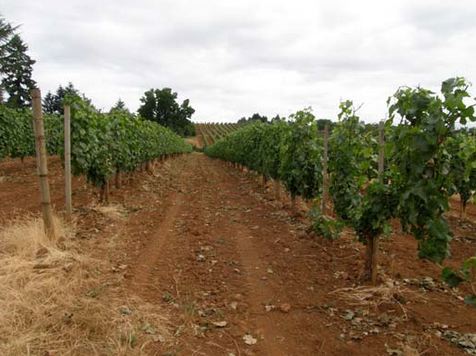 The Pinot Noir from the Dundee Hills is typically nuanced, delicate, and fruit-centric, with good acidity and soft and silky textures. Fruits are typically red but can be black in warmer vintages and tastes of earth, cola, sassafras, Dr. Pepper, and baking spices combined with floral aromatics are common. The De Ponte Pinot Noirs epitomize this profile. De Ponte Cellars Pinot Noir is sold online at www.depontecellars.com. Tasting is available daily at the winery, located just off Breyman Orchards Road at the western end of the Dundee Hills or in Carlton at the Lonesome Rock Ranch Firehouse, open Friday-Sunday. The 2014 vintage Pinot Noir wines are available through February for an additional 10% off all case sales in addition to club discount. Some past vintages are available on the website. I sampled four newly released 2014 De Ponte Cellars Pinot Noirs. Oregon Pinot Noir from the 2014 vintage is pretty much a no-brainer. The growing season was flawless from start to finish. The wines are sensual, with the right blend of savory and fruit characters. They are generous now but will perform beautifully after a few years in the cellar. You can’t go wrong picking any of this litter.
2014 De Ponte Cellars Dundee Hills Oregon Pinot Noir 14.1% alc., 1,156 cases, $44. This wine is composed of vineyard blocks throughout the estate property. Aged 12 months in French oak barrels, 20% new. · Moderate reddish purple color in the glass. Very savory nose, with aromas of forested path, spice and cherry. Noticeable attack, mid palate purpose and follow through of intense cherry goodness. A bit earthy, with the taste of iron-rich soil coming through. Nicely composed, with gentle tannins, and an assertive finish. A welcoming ode to the Dundee Hills AVA. Score: 92
2014 De Ponte Cellars Estate Dundee Hills Oregon Pinot Noir 14.2% alc., 432 cases, $60. A limited bottling from the most prized vineyard blocks and select barrels. Aged 12 months in French oak barrels, 50% new. · Moderate reddish purple color in the glass. The dreamy nose reminds of walking through an angel garden with aromas of loam, pine needle, alpine flora and black cherry. Delicious mid weight flavors of black cherry, raspberry and spice with a thread of iron “minerality.” Elegant, silky and gorgeous, with refined tannins, juicy acidity and a very long and memorable finish. As good as the Dundee Hills bottling is, this wine is a step up in class. Score: 94
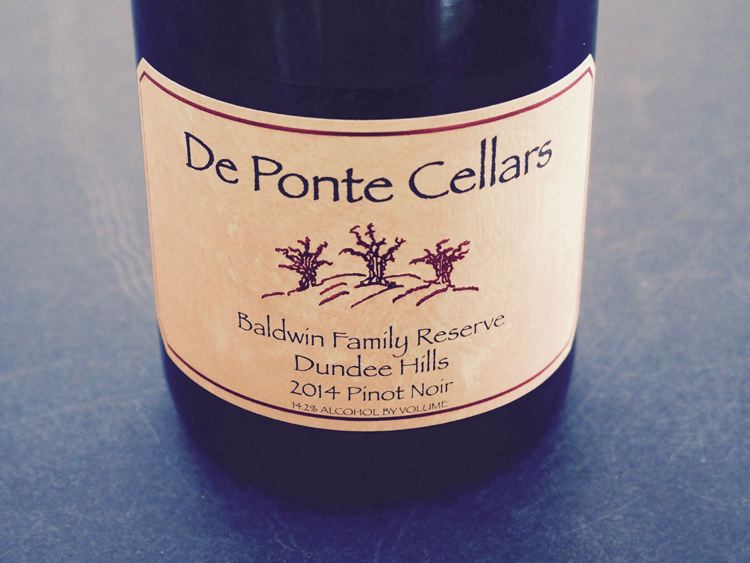 2014 De Ponte Cellars Baldwin Family Reserve Dundee Hills Oregon Pinot Noir 14.2% alc., 219 cases, $75. Typically a richer, more full-bodied offering that is the winery’s most limited production. Aged 12 months in French oak barrels, 80% new. · Moderately dark reddish purple color in the glass. The nose offers a luxurious deep black cherry perfume that raises the senses like a pheromone. The flavor profile is similar to the Estate bottling, but this wine has more structure and fruit sap. Striking mid palate presence of deliciously ripe dark cherry, blueberry and black raspberry fruits that are delicately spiced. A dreamy wine that has a slightly creamy texture, noticeable but supportive tannins, and a long finish that is almost too good to be true. Still seductive when tasted two days later from a previously opened and re-corked bottle. Score: 95
2014 De Ponte Cellars Lonesome Rock Ranch Willamette Valley Pinot Noir 14.1% alc., 742 cases, $44. Aged 12 months in French oak barrels, 20% new. · Moderately light reddish purple color in the glass. Complex nose with aromas of black cherry, cranberry, brier, pine tree, terra cotta and gravelly soil. Light to mid weight in style and quite elegant, yet offering intriguing flavors of black cherry and purple berry with a subtle chalky flavor and texture. Quite distinctive from the De Ponte Estate Pinot Noirs, with a lighter frame, a little more tannin and a grounded, earthy quality. In this case, being different is a good thing. Score: 93
FEL Wines Always On PointSince 2014, when Cliff Lede, proprietor of Lede Family Wines in Napa Valley, expanded into Pinot Noir, Pinot Gris and Chardonnay production in the Anderson Valley, the wines have been consistently on point. Winemaker Ryan Hodgins is a very talented graduate of University of California at Davis with a Master’s Degree in Viticulture & Enology. He was profiled at the World of Pinot Noir in 2015: www.princeofpinot.com/ article/1671/.
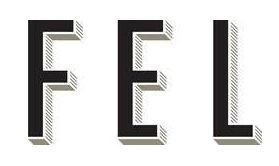 Vineyard sources are superb including Savoy Vineyard, now owned by Lede, Ferrington Vineyard and Donnelly Creek Vineyard, all located in the Anderson Valley, and Hirsch Vineyard in The Sonoma Coast. The vineyarddesignated wines reviewed here are available directly from the winery and for wine club members. Visit www.felwines.com. Tasting is available inside the Cliff Lede Vineyards 1913 Craftsman-style tasting room in Yountville that is open daily. Various tasting options are offered. The 2014 vintage in the Anderson Valley and Sonoma Coast featured a warm spring and an early bud break in March, ultimately leading to an early harvest. September weather was moderate, allowing grapes to be picked as flavors developed in sync with balanced acidity. The condensed harvest led to long days in the winery, but the resulting wines show a pedigree only found in great vintages. The three wines reviewed here have the same divine score but are distinctively different.
2014 FEL Donnelly Creek Vineyard Anderson Valley Pinot Noir 14.8% alc., 191 cases, $65. Released February 1, 2017. Harvest Brix average 24.6º. Pommard and Stang clones. 7-day cold soak, 9-day uninoculated primary fermentation, and a 4 to 6-day extended maceration. Aged 16 months in French oak barrels, 50% new. · Moderately dark reddish purple color in the glass. Well perfumed with deep aromas of red cherry, ripe strawberry and yeasty dough. Lush and seductive on the palate, with a mid weight plus charge of enticing flavors of black cherry, blueberry, pomegranate and dark chocolate. Very hedonistic like a busty girl with big lips that you just can’t take your eyes off of. Relatively high in alcohol, but nicely balanced with an amazing finish that won’t quit. Score: 93
2014 FEL Ferrington Vineyard Anderson Valley Pinot Noir 14.3% alc., 241 cases, $65. Release December 1, 2016. Harvest Brix average 24.2º. Wädenswil and dijon 777 and 115.7-day cold soak, 9-day uninoculated primary fermentation, and a 5-day extended maceration. Aged 15 months in French oak barrels, 52% new. · Moderately light reddish purple color in the glass. An earthy, grounded wine featuring aromas of dark grape jam, dark red cherries and toasty oak. A bit tight and burly at present, but relinquishes delicious Bing cherry flavor accented with cola, sarsaparilla and toasty oak. Silk and satin in the mouth, with agreeable tannins and a dark cherry filled finish. Score: 93
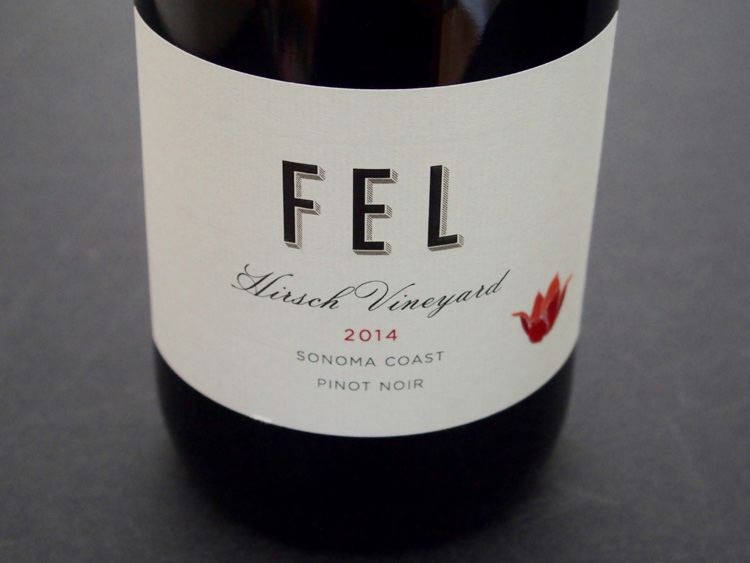 2014 FEL Hirsch Vineyard Sonoma Coast Pinot Noir 14.3% alc., 291 cases, $65. Released February 1, 2017. Average harvest Brix 24.1º. A blend of Dijon 777 and Pommard clones from two blocks of Hirsch Vineyard. 5-day cold soak, 8-day uninoculated primary fermentation, and a 3 to 8-day extended maceration. Aged 16 months in French oak barrels, 38% new. · Light cherry red color in the glass. Interesting aromas of black cherry, strawberry, clove and nori. Light to mid weight in style, with a tempting cherry core embellished with cardamom, clove and other spices. A spirited wine with a very appealing velvety texture, integrated tannins, and a lip-smacking finish filled with spiced cherry goodness. Score: 93
More Good Stuff
Joseph Jewell Wines, Cloverdale, CAMicah Joseph Wirth and Adrian Jewell Manspeaker craft small quantities of Pinot Noir sourced from vineyards in the Russian River Valley and Humboldt County. Visit www.josephjewell.com.
2014 Joseph Jewell Humboldt County Pinot Noir 13.6% alc., pH 3.58, TA 0.59, 175 cases, $32. A blend of grapes from Elk Prarie, Alderpoint and Ryan vineyards. A mix of Dijon 115, 777, and 667, along with Pommard and Martini clones. Harvest Brix averaged 24.4º. Average yield 0.50 tons per acre. 100% de-stemmed, aged 10 months in French oak barrels, 20% new. Bottled unfined and unfiltered. · Moderate reddish purple color in the glass. Very giving aromas of cherry, strawberry, raspberry, bark and a hint of tutti-frutti. Darker fruited flavors on the palate including black cherry and black raspberry with a pleasing hint of spice. Nicely balanced and quite agreeable, with filigree tannins and some finishing length. Score: 89
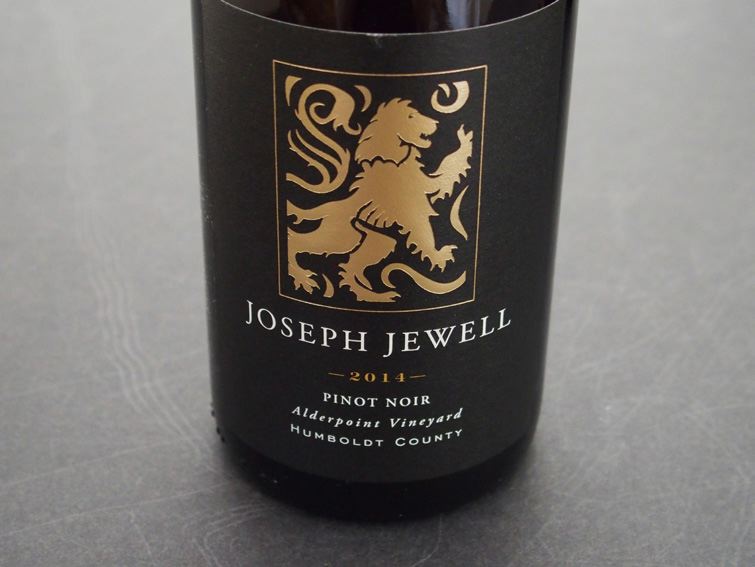 2014 Joseph Jewell Alderpoint Vineyard Humboldt County Pinot Noir 13.9% alc., pH 3.59, TA 0.62, 75 cases, $35. Vineyard is located at 500 feet elevation above the middle fork of the Eel River. First open release from this vineyard. Martini clone planted in 1991. Yield averaged 1.99 tons per acre. Harvest Brix 23.2º. Aged 11 months in French oak barrels, 33% new. Bottled unfined and unfiltered. · Moderately light reddish purple color in the glass. Both earthy and fruity in character, with aromas and flavors of black raspberry and blackberry fruits, spice, mushroom and mulch. Silky in the mouth, with welcome balance, and a return of the savory and fruity fragrances that haunt the exhilarating finish. Score: 92
2014 Joseph Jewell Bucher Vineyard Russian River Valley Pinot Noir 13.7% alc., pH 3.62, TA 0.57, 75 cases, $45. Clones 777 and Pommard 5. 100% de-stemmed, aged 10 months in French oak barrels, 33% new. Bottled unfined and unfiltered. · Moderate reddish purple color in the glass. A highly individualistic wine that displays the typical scent and flavor of guaiacol and mulch associated with this vineyard. The wine is centered around a black cherry flavored core in a silky and elegantly style with gentle tannins and impressive length on the finish. Beautifully crafted in a harmonious fashion. Score: 92
2014 Joseph Jewell Rubies Russian River Valley Pinot Noir 14.2% alc., pH 3.51, TA ).59, 100 cases, $N/A. An annual wine club exclusive offering representing the finest barrels of each harvest. 50% Hallberg Vineyard clones 777 and Pommard 5, 25% Floodgate Vineyard clones 777, 667, 115 and Pommard 4, and 25% Appian Way Vineyard clones 115, 777 and Pommard 4 and 5. 100% de-stemmed grapes, aged 18 months in French oak barrels, 33% new. Bottled unfined and unfiltered. · Moderately dark reddish purple color in the glass. The nose is rather shy, offering demure aromas of blackberry jam and prune. Very ripe flavors of blackberry, raisin and cassis with an oak-driven marzipan note. Very silky, with supportive tannins and some length on the finish. Considerably more appealing when tasted the following day from a previously opened and re-corked bottle, showing more fruit expression including additional flavors of black plum, black raspberry and spice, and still sporting considerable length on a fruit-driven finish. This wine definitely needs more time in bottle. The extreme ripeness of the fruit may or may not be a liability depending on your taste. Score: 91
Lichen Estate, Anderson Valley, CAThe Lichen Estate Vineyard was planted in 2008 when the owners were operating Breggo Cellars that was founded on a former sheep ranch in 2005. The brand was sold in 2009, but the land was retained. At the end of 2014, the Breggo lease ended and Lichen’s first estate grown wines were produced. The name, Lichen, reflects the widespread Lichen covered hillsides in the Anderson Valley. Winegrowers Douglas and Ana Lucia Stewart farm their high density planted vineyard organically. It is planted to four clones of Pinot Noir (Martini, Wädenswil, Pommard and Dijon 667) on three rootstocks. There is a smaller planting of Pinot Gris. The winery’s tasting room is open Thursday-Monday in Boonville. Visit www.lichenestate.com.
2015 Lichen Estate Moonglow Anderson Valley Pinot Noir 13.1% alc., pH 3.51, TA 0.56, 324 cases, $35. Released October 2016. 100% Lichen Estate fruit, all four clones, harvest Brix 22.0º-24.0º. 3 to 4-day cold soak, fermented 14-17 days in closed-top stainless fermenters followed by a 2 to 3-day extended maceration. Aged 11 months in French oak barrels, extra tight grain, medium toast, about 20% new. · Moderately light cherry red color in the glass. Readily accessible aromas of red cherry, raspberry coulis, red licorice, rose petal and rose stem. Relatively light in weight in a very pleasant, easy-drinking style, featuring red cherry and berry flavors, sleek tannins, and a juicy finish highlighted with raspberry fruit. Score: 89
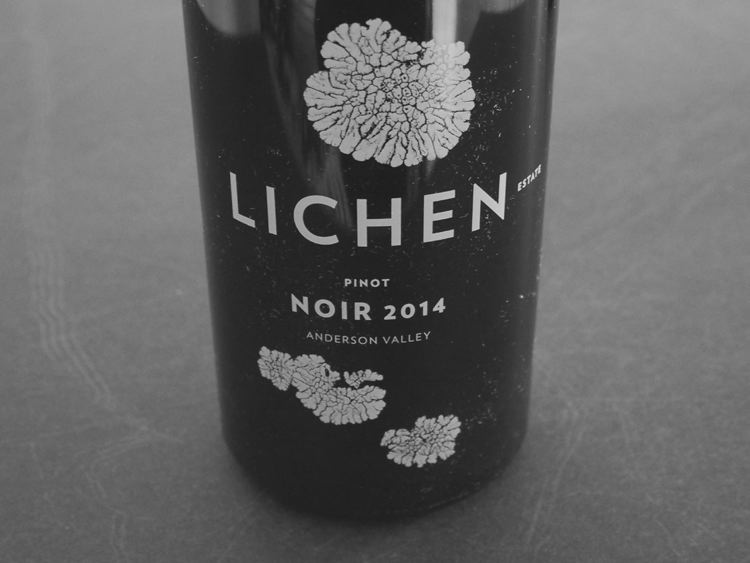 2014 Lichen Estate Anderson Valley Pinot Noir 13.9% alc., pH 3.48, TA 0.56, 182 cases, $65. Released October 2016. Harvest Brix 22.4º-24.6º. 5 to 6-day cold soak, 14 to 17-day fermentation and 2 to 3- day extended maceration. Aged 17 months on the lees with stirring the first 9 months in French oak barrels, extra tight grain wood, medium plus toast Francoise Frères. · Moderately light reddish purple color in the glass. Perfumed and sensuous, with deep aromas of cherry, spice, brier and earthy flora. Lush and satisfying on the mid weight palate, with robust cherry flavor accented with a subtle thread of cola and spicy oak. Beautifully balanced, with silky tannins and a bright, juicy finish. Very classy juice. Score: 93
ROAR Wines, San Francisco, CAROAR Wines is owned by Gary and Rosella Franscioni, who also own the nearby Garys’ Vineyard (50 acres planted in 1997) and Soberanes Vineyard (35 acres planted in 2008) in partnership with the Pisoni family, and are the sole owners of Sierra Mar Vineyard (38 acres planted in 2007) and Rosella’s Vineyard (50 acres planted in 1996). The name, “ROAR,” is derived from the sound of the ocean winds that whip through the Santa Lucia Highlands. The winemakers are Gary Franscioni and his son Adam together with Scott Shapley and are made at an urban winery in San Francisco. ROAR produces Pinot Noir, Syrah, Chardonnay and Viognier from grapes grown at Rosella’s, Garys’, Sierra Mar, Soberanes, and Pisoni vineyards in the Santa Lucia Highlands. The wines are sold primarily through a mailing list at www.roarwines.com. The Franscioni family is pictured below (including their dog “Tiger”).
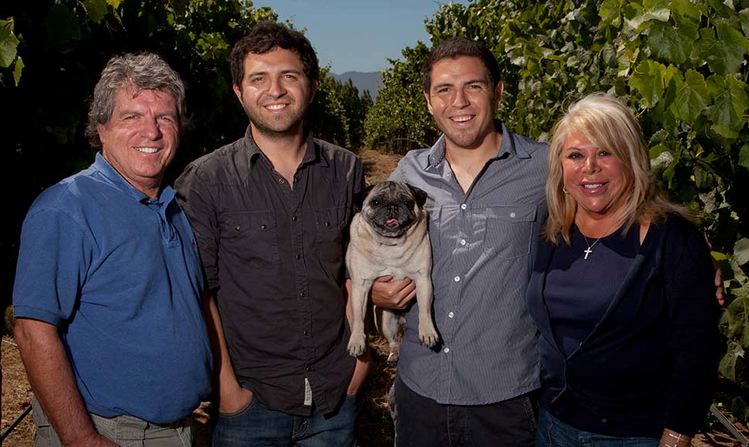 The wines reviewed here are the February 2017 releases. The grapes for these wines were clearly picked very ripe, but the fruit does not taste of compote or jam, and admirable balance makes the wines very agreeable. The high percentage of new oak makes an impression, but is not overbearing. Silky elegance is a common thread. The wines are still very young and the scores may be a conservative underestimate compared to a sampling after another year in bottle.
2015 ROAR Santa Lucia Highlands Pinot Noir 14.4% alc., pH 3.73, TA 0.58, 1,360 cases, $43. Harvest Brix 25.6º-28.4º. Swan, Pisoni, Pommard, 23, 777, 943, 115 and “828” clones. The juice spent an average of 28 days on the skins and aged 10 months in French oak barrels, 55% new. Bottled unfined and unfiltered. · Moderate reddish purple color in the glass with a slight cloudiness. Revealing aromas of cherry, strawberry, soy and smoke. A comforting wine that is easy to cozy up to, with mid weight flavors of well-spiced dark cherry and purple berry. Sleek in texture, with taut tannins and a pleasing finish. Score: 89
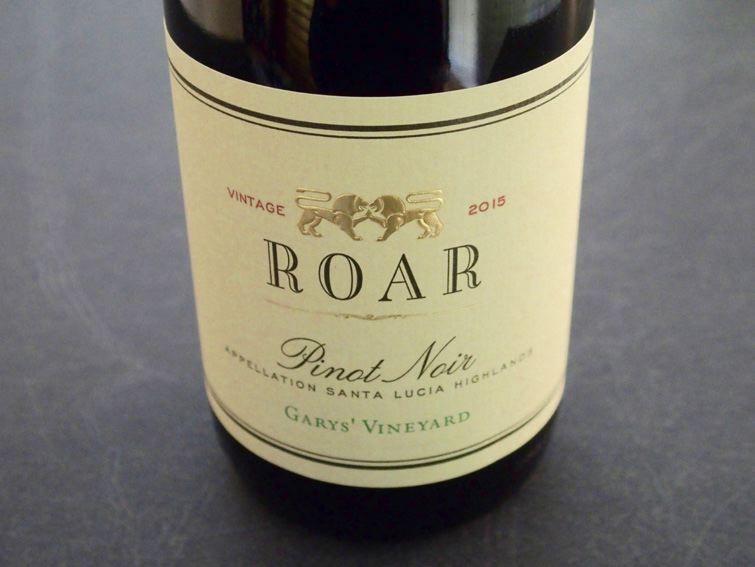 2015 ROAR Garys’ Vineyard Santa Lucia Highlands Pinot Noir 14.9% alc., pH 3.71, TA 0.59, 493 cases, $60. Harvest Brix 26.76º-27.1º. Pisoni clone. The juice spent an average of 33 days on the skins and aged 11 months in French oak barrels, 65% new. Bottled unfined and unfiltered. · Moderate reddish purple color and slight haze in the glass. Lovely cherry pie aroma with a hint of red rose and toast. The arsenal of black cherry, black raspberry and blackberry fruits have impressive purity, ever-expanding in the mouth and on the finish. Ripe but not too ripe. There still is a bit of oak hangover from bottling, but this is sure to integrate over time. This vineyard always delivers the combination of virility and charm. Score: 93
2015 ROAR Sierra Mar Vineyard Santa Lucia Highlands Pinot Noir 14.5% alc., pH 3.77, TA 0.58, 516 cases, $60. Harvest Brix 25.6º-28.3º. Swan, Pisoni and “828” clones. The juice spent an average of 28 days on the skins and aged 11 months in French oak barrels, 68% new. Bottled unfined and unfiltered. · Moderately dark reddish purple color in the glass. Aromas of Bing cherry, spice and sous-bois lead off. Quite juicy in the mouth, with middleweight core of black cherry and black raspberry flavors that are expansive. Silky in texture, with a compliment of toast and caramel, energized with adequate acidity, and finishing with some length revealing young, dry tannins. Score: 92
2015 ROAR Sierra Mar Vineyard Santa Lucia Highlands Chardonnay 14.6% alc., pH 3.54, TA 0.61, 307 cases, $45. Harvest Brix 24.2º. Monty and Hyde clones. The wine underwent 100% malolactic fermentation in barrel and was aged 11 months in French oak barrels, 30% new, before being fined in August 2016. · Moderate golden yellow color and clear in the glass. This is at first take a bombastic wine, yet with further examination yields considerably complexity. Aromas of salt air, lemon oil, pineapple and other tropical fruits, nuts and buttered toast lead to a boldly flavored wine with tastes of citrus, pear, tropical fruits, white chocolate and blond caramel. Mouth filling with a viscous mouthfeel, yet enough acidity to propel the wine through a bright finish. Score: 92
Senses Wines, Calistoga, CAThree childhood friends, Chris Strieter, Max Thieriot and Myles Lawrence-Briggs, partnered with noted winemaker Thomas Rivers Brown to produce Pinot Noir and Chardonnay from West Sonoma Coast vineyard sites. The wines are offered directly to a mailing list twice a year. Visit www.senseswines.com. The 2014 growing season on the West Sonoma Coast offered mild and steady warmth and dry conditions making for an ideal harvest.
2014 Senses Sonoma Coast Pinot Noir 13.8% alc., $45. Aged 10 months in French oak barrels, 20% new. · Moderately light reddish purple color in the glass. The nose is filled with aromas of cherry, strawberry, blueberry and spice. Light to mid weight in a laid-back style, with flavors of plum and dark red strawberry with a subtle oak spice compliment. Very giving and elegantly composed, with a comforting texture and a carefree finish. Score: 90
 2014 Senses Hillcrest Estate Vineyard Sonoma Coast Pinot Noir 13.6% alc., $65. Myles Lawrence-Briggs’ parents, Carl Biggs and Lisa Lawrence, bought this site in 1988, located just outside the town of Occidental. The vineyard neighbors the Charles Heintz Vineyard to the west and is home to the original Chardonnay planting in the West Sonoma Coast (since replanted to Pinot Noir. 2 acres of clones 115 and “828,” and Calera and Swan selections planted in 2005 in Goldridge sandy loam soils. Aged 10 months in French oak barrels, 35% new. Well-perfumed with aromas of red berries, spice and a hint of smoke. · Well-perfumed with aromas of red berries, spice and a hint of smoke. Delightful mid weight flavors of dark red cherry and black raspberry with a sprinkling of woodland spice and smoke. Nothing out of place, with a mellow texture and a finish that grabs the heart with a soaring black cherry note. Score: 92
Readers Chime In on Aging Pinot NoirSandy Porter from North Carolina wrote me about a vertical tasting of aged Davis Family Russian River Valley Pinot Noir, 2002-2009, that she conducted with her 20-member wine tasting group recently. The group consisted of experienced tasters who sampled the wines double blind.
The consensus of the group was that the wines were either red Burgundy or Oregon Pinot Noir, primarily based on the amount of evident acidity and faded fruit. Among the wines of Flight One, 2002-2005, tasters preferred the 2005, but there were votes for all four wines as “favorites.” Several tasters realized they were tasting a vertical based on similarity of style. After the Second Flight, 2006-2009, the group agreed that the wines were more California in style although the 2006 and 2007 vintages were thought to be red Burgundy by some. When comparing the two flights, the group did believe they were drinking a vertical, but thought the wines were younger, perhaps 2007-2014. Surprisingly, 19 out of 20 tasters chose the First Flight as their overall favorite and while the 2004 and 2005 vintages received a majority of votes, some voted for the 2002 and 2003 vintages as well. There were no comments about the wines being past their prime. The group consensus was that based on this tasting, they would not hesitate to age their California Pinot Noir.
Iain Liston-Brown wrote that the results of my recent tasting of aged California Pinot Noir matched his own findings over the past twenty years. Being European (a Brit actually), there is a tendency to cellar wines longer than Americans. Over the years, he has found more failures than successes when cellaring 10+ years and find the optimum to be 5-7 years (as I did in my report). Iain noted, “This drinking window allows the wines to retain their fruit properties that are the highlights of these wines. The secondary flavors and acidity do not balance out older wines in general. It is not worth waiting, except for a few wineries such as Calera, Mount Eden and some select Littorai bottlings.” He reports that his 2008 vintage California Pinot Noirs are being consumed now and he has very few older California Pinot Noirs left.
An interesting study was reported at this year’s WineHealth 2017 conference in Spain that brings up the question of the comparative health benefits of young versus aged red wines. Polyphenols in red wines are thought to provide additional health-enhancing properties beyond those available from alcohol. It is known that the biochemical profile of red wines change with aging. Grape pigments and other polyphenols degrade and reform into new and more stable compounds, a phenomenon occurring over weeks, months and years. A study by Americans Dr. Tedd Goldfinger and Dr. Andrew Waterhouse looked at five single-vineyard red wines from vineyards in Napa, Sonoma and Italy (Barolo) at intervals from wines that were 20+ years old up to new barrel samples. Analysis was performed by an accredited wine laboratory. Total anthocyanin (a polyphenol) content declined during aging while antioxidant capacity was unchanged. They concluded that slow oxidation of red wine in the bottle leads to polymerization of phenolics. The phenolics are not lost, but combine to form new compounds. As these polymers are derived compounds, it is not clear what biologic activity they might have that may be different from the “natural” compounds. This begs the question, “Do young or aged red wines confer the most health benefit found from drinking red wine in moderation?”
Synopsis of WineHealth 2017For a number of years in the past, I reported on the Wine & Heart Health Summit held in various wine regions in California and Oregon. I attended the first meeting, held in 2001 in Napa Valley. Regular attendees became members of the Renaud Society. That event is no longer conducted and has been replaced by the Wine and Health international conference that brings together world experts for the exchange of scientific information on the impact of wine consumption on human health. The scientific committee for that event includes American doctors R. Curtis Ellison, Professor of Medicine and Public Health at Boston University School of Medicine, Tedd Goldfinger, a cardiologist in Tucson, Arizona, and Andrew L. Waterhouse, a well known wine chemist who is a Professor of Enology in the Department of Viticulture and Enology at University of California at Davis. WineHealth 2017 was held February 16-18, 2017, in Spain: www.winehealth2017.com. The conference is based on the epidemiological evidence that moderate red wine consumption is inversely associated with a decline in cognitive function and seems to exert cardioprotection and reduce the prevalence of the metabolic syndrome (a combination of risk factors that occur together and increase the risk for coronary heart disease, stroke and type 2 diabetes). Some studies favor ethanol effects alone while others support the contribution of wine micro-constituents in combination.
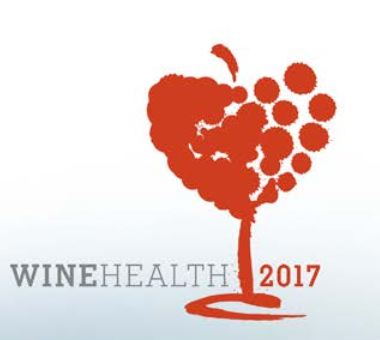 I have summarized the important presentations and research studies that were part of WineHealth 2017, and tried to describe them in terms the lay public can understand. This summary provides the interested reader with an understanding of the most current alcohol, wine and health research.
“Wine, Mediterranean Diet and cardiovascular disease. Lessons from the PREDIMED trial” Dr. Ramon Estruch, University of Barcelona, Spain, and CIBEROBN, Spain. Dr. Estruch started the PREDIMED study in 2003 to evaluate the effects of a Mediterranean diet on the primary prevention of cardiovascular diseases. The main results have been published in several medical journals. The PREDIMED trial has demonstrated that an increased adherence to the traditional Mediterranean Diet is associated with reduced incidence of cardiovascular events. Participants in the trial with a low incidence of cardiovascular disease and stroke were those with higher consumption of wine, extra-virgin olive oil, coffee and walnuts, all foods rich in polyphenols. One PREDIMED trail showed that wine and beer, fish and legume intake were found to be particularly responsible for the Mediterranean Diet benefits on HDL (good cholesterol) function in a random sample of high cardiovascular risk volunteers following a Mediterranean Diet. In another PREDIMED trial, it was found that light (less than 5 grams of alcohol per day) and moderate (5 to 15 grams of alcohol per day) consumers of wine and specifically red wine, showed a 38% reduction of all-cause mortality. Moderate and high (more than 15 grams to 70 grams of alcohol per day) wine consumers exhibited a 30% to 70% reduction, respectively, in the incidence of major cardiovascular events. This higher effect of red wine compared to other alcoholic beverages has been attributed to its high polyphenol content.
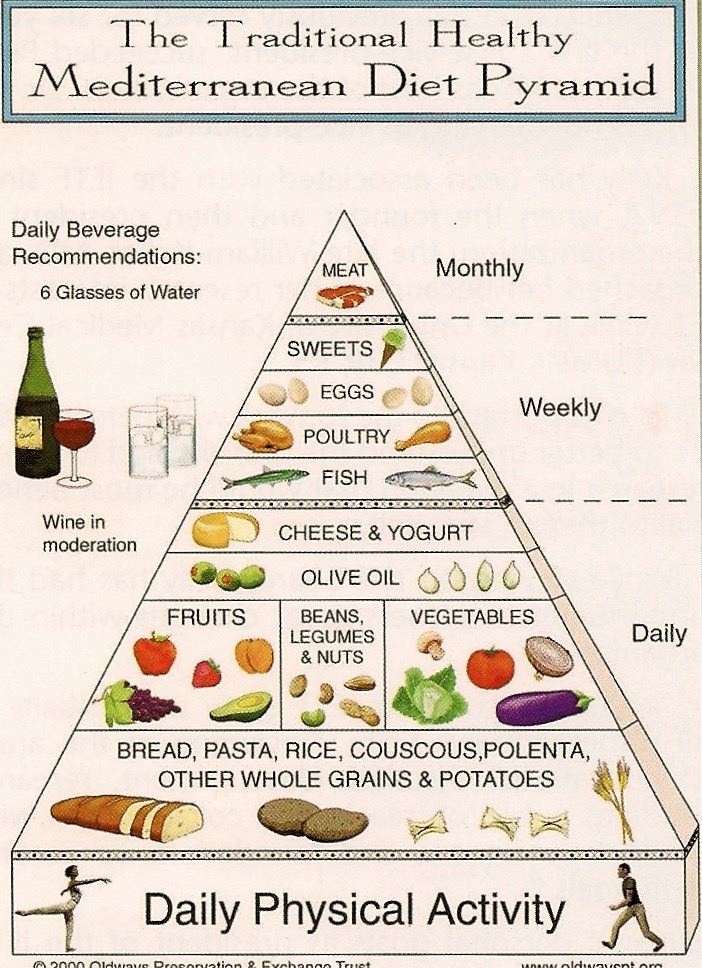
“Update on the J-shaped curve: where are we now?” R. Curtis Ellison, M.D. Epidemiological studies have consistently shown that, when compared with non drinkers, light-to-moderate consumers of alcoholic beverages have a lower risk of cardiovascular disease and also a reduced risk of other diseases and total mortality. Heavy-drinking subjects show a greater risk than non-drinkers and moderate drinkers. This phenomenon results in what is known as the “J-shaped curve.” The J-shaped curve has held up in most recent, high-quality studies when only lifetime non-drinkers make up the non-drinking category. Experimental studies in animals have shown a similar pattern: a decrease in risk with light or moderate exposure to alcohol, and increased risk with high exposure. Unfortunately, most epidemiological studies have not adequately controlled for the pattern of drinking even though it is known that regular moderate consumers of alcohol have clear health advantages over binge drinkers of the same average amount of intake. It is anticipated that when more accurate assessments of actual alcohol consumption and drinking patterns become available (rather than the average amount of alcohol consumed over a week or month), even greater protection against disease from moderate drinking will be shown, especially when the beverage of choice is wine. The J-shaped curve:
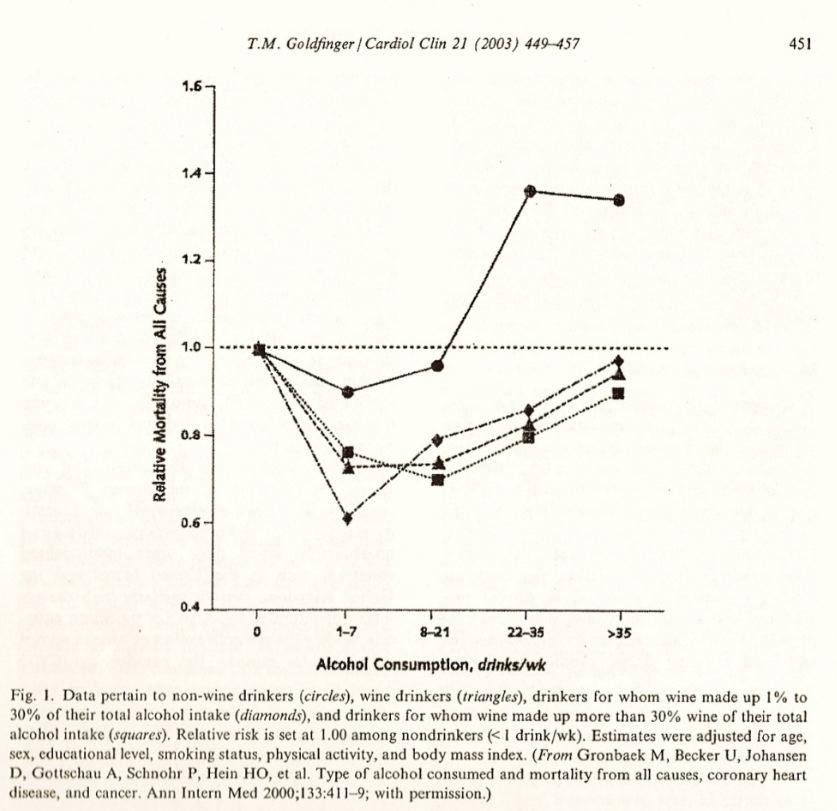
“Different effects of wine, beer and spirits on health” Professor Giovanni de Gaetano, M.D., IRCCS Istituto Neurologico NEUROMED, Pozzilli, Italy A large meta-analysis (a statistical analysis combining the results of multiple scientific studies) provided evidence of a J-shaped relationship between both regular wine and beer intake and non-fatal vascular risk, with maximal protection at moderate consumption of around 25 grams per day of alcohol. A standard drink in the United States is any alcoholic drink that contains about 15 grams of alcohol, equivalent to about 5 ounces of table wine or 12 ounces of 5% alcohol beer. Such protection was not seen when drinking beyond moderation or more than 30 grams of alcohol per day or binge drinking. A statistically significant association between spirits intake and vascular disease could not be found. A J-shaped curve was also confirmed for total mortality, with 25% maximal risk reduction at approximately 10 grams per day and significant protection up to 40 grams per day of alcohol. The finding of an inverse association between the consumption of wine or beer in relation to cardiovascular outcomes may be reasonably explained by a combined effect of alcohol and of different but similarly beneficial polyphenols contained in either beverage. It is speculated that consuming wine or beer, especially during meals, favors synergistic effects between alcohol and polyphenols contained both in wine or beer and in other components of the Mediterranean diet.
“Effects of alcoholic beverages such as wine on lipid and other biomarkers for cardiovascular disease” Dr. Henk Hendriks, Hendriks Nutrition Support for Business, Zeist, The Netherlands. Healthy lifestyle factors like non-smoking, physical activity and a healthy diet are associated with a decreased risk for mortality and metabolic disease. It appears that a risk reduction in cardiovascular disease due to moderate alcohol consumption is additive to the beneficial effects of other healthy life style factors. The main processes that are beneficially affected by moderate wine or alcohol consumption with regard to cardiovascular disease are lipid (cholesterol) metabolism (an increase in good cholesterol or HDL and functioning), blood clotting (decrease in fibrinogen) and glucose metabolism (decrease in HbA1c). These processes combined may explain the larger part of the reduced risk for cardiovascular mortality associated with moderate wine consumption.
Other conclusions from reported studies at WineHealth 2017: A randomized prospective clinical trial showed that the alcoholic and the non-alcoholic fraction of wine, rich in polyphenols, may reduce circulating endothelial cells (CEC), a marker of cardiovascular severity, and increase endothelial progenitor cells (EPC), a marker of vascular endothelial regeneration in a population at high risk of cardiovascular disease. These features may explain why de-alcoholized red wine and moderate red wine consumption reduce cardiovascular risk, suggesting an improvement in the condition of the vascular endothelium (lining) and possibly delay in development of atherosclerotic plaques. A study of an elderly Mediterranean population (cohort) at high risk for cardiovascular disease showed that light and moderate consumption of alcoholic beverages, mainly red wine, was inversely associated with total mortality and major cardiovascular events. In Mediterranean countries such as Spain, moderate wine drinkers show a higher adherence to the Mediterranean Diet than beer or spirit consumers, and predominantly wine consumers showed lower body weight than beer and spirit consumers.
Still more relevant recently published studies not reported at WineHealth 2017: Researchers at the University of California in Los Angeles published a study in the journal Experimental Gerontology that showed that the polyphenols such as resveratrol in grapes can promote brain activity in patients with early onset cognitive decline. The study involved five elderly men and five elderly women who had a mild decrease in cognitive function for at least six months. Half of the study participants took a daily placebo and half a freeze-dried powder made from California red grapes (equivalent to three standard servings of grapes or one and a half glasses of wine). Several studies were conducted at the onset of the study and after six months of treatment, including brain PET scans that measure metabolism in different regions of the brain. The regions of the brain that are found to have less activity in early Alzheimer’s Disease also became less active in the subjects on the placebo, but those who received the grape powder had no significant decrease in brain metabolism. Obtaining maximum health benefits from moderate consumption of alcohol critically depends on the pattern of drinking. A review published in 2016 in the journal Food and Function, looked at past studies and seven measures of drinking patterns. They concluded that wine drinkers have a lower rate of mortality than those who regularly drink beer or spirits. It was also evident that the cardioprotective effects of wine increase when it is consumed with a well-balanced diet.
Pinot BriefsPinot Noir Searches on Wine-Searcher at All-Time High Wine-Searcher’s David Allen MW reported at the Pinot Noir NZ Conference in Wellington, New Zealand, held January 31 to February 3, 2017, that more than 13 million searches were made for wines produced from Pinot Noir on the Wine-Searcher website. The majority of these searches were for wines from Burgundy, but 16 percent of searches looked for California Pinot Noir and 5 percent were after those from Oregon. Poor Correlation Among Wine Critics’ Quality Scores David Morrison, author of The Wine Gourd Blog at www.winegourd.blogspot.com examined a direct comparison of the quality scores from respected sources of advice, including the Wine Spectator, the Wine Advocate, the Wine Enthusiast, Wine & Spirits Magazine, and Jancis Robinson, along with a few less familiar sources. Morrison used Penfolds Grange Bin 95 and compared the quality scores of the various wine critics over a long series of vintages. He concluded that in general, consensus agreement varies from 0-50%, so that critics disagree more than they agree. Attributes Consumers Use to Buy Wine It would seem that consumers put more importance on recommendations by friends or relatives than experts in the media:
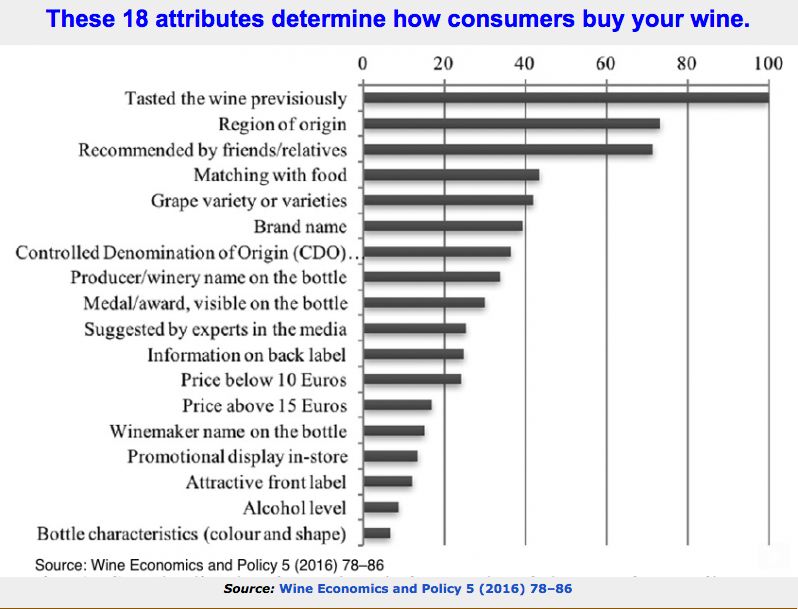 Revelations About Current State of North Coast Higher-End Wine Jeff Quackenbush published an article in the North Bay Business Journal, February 21, 2017, in which Bill Rodda, managing director of agribusiness for Santa Rosa-based American AgCredit, and Dan Aguilar, a veteran wine banker, spoke about consumer’s thirst for higher-end wine in the North Coast and the intensifying demand for sources of capital. In the North Coast, demand for vineyards continues to be strong and vineyard values have gone up 10-15 percent in the past year. Records were set in Sonoma County for value of Pinot Noir acreage when a pension fund deal was consummated in Annapolis for $170,000 an acre - probably the top end at present. Wineries continue to attempt to secure their grape sources by buying vineyards and much of what’s available has been purchased by the large wineries such as Gallo, Jackson Family Wines, Vintage Wine Estates and The Wine Group. Increasing vineyard and winery values are driven by the fact that regulators are not approving new vineyard sites and production facilities. Although there continues to be significant demand for existing and new winery companies to get approvals to build production facilities and tasting rooms, it is difficult to obtain approvals in Sonoma and Napa counties. Napa is nearly planted out and Sonoma County is not approving hillside vineyards while much of the flatland is already planted. Website Devoted to Women Winemakers Lucia and Jack Gilbert, professors at Santa Clara University, maintain a website, Women Winemakers of California, listing women winemakers: www.womenwinemakers.com. They offer a searchable resource that introduces the talented women winemakers in California, providing the most comprehensive and accurate information currently available on women winemakers in California. The website also offers information and links regarding women who are winemakers in the United States other than California.
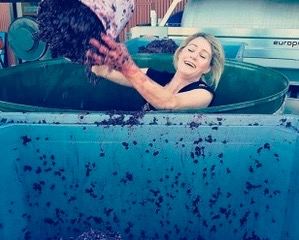 U.S. Wine Exports Reach Record $1.62 Billion in 2016 California accounted for 90% of the record U.S. wine exports. California wine exports have grown 78% by value in the last decade. The top 10 export markets for California wines are the European Union’s 28-member countries, Canada, Hong Kong, Japan, China, Mexico, South Korea, Switzerland and Singapore.
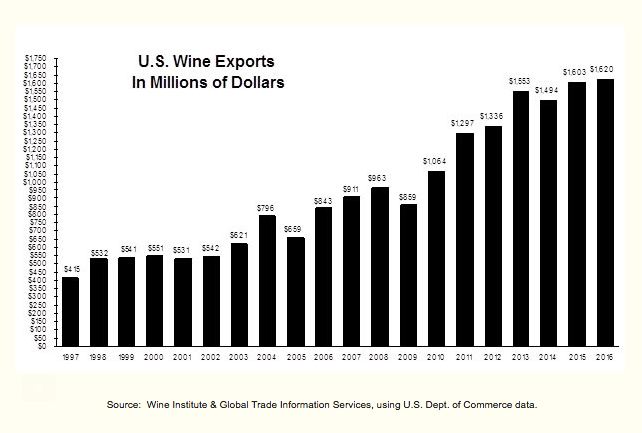 Pinot Noir Vinified Like Coca-Cola At the recent Oregon Wine Symposium, Michael Davies, executive winemaker at A to Z Wineworks in Newberg, Oregon, said that he seeks to minimize vintage variation in A to Z Pinot Noir, because “even if its effects on a wine are interesting, no one’s explaining those effects to buyers in the supermarket.” He claimed that the average supermarket buyer isn’t paying attention to the vintage of a supermarket wine. His assumption is undoubtedly correct, but A to Z Pinot Noir is a quaff intended for the supermarket buyer intent on buying inexpensive wine, so it falls into the category of Coca-Cola which is often discounted and consistently the same. Vintage does make a BIG difference in Oregon, and this fact should never be forgotten in marketing and promotion of Oregon Pinot Noir. Adelsheim Vineyard Announces New CEO Joth Ricci, an Oregon native who has recently been the President of Stumptown Coffee Roasters based in Portland, Oregon, and a beverage industry veteran, is the new CEO, taking over for Founder and President David Adelsheim. Ricci will assume all the day-to-day operations but David will still have an active role within the winery and continue to shape the winery’s legacy. He will continue to serve as Chairman of the Board of Directors with Lynn and Jack Lynn Loacker, who joined as partners in 1994. Adelsheim Vineyard is committed to staying independently and locally owned. Results of 2017 San Francisco Chronicle Wine Competition With 7,000 entries from 28 states across the country, this judging is hailed as the largest competition of American wines in the world. Best of Class winners for Pinot Noir:
Pinot Noir up to $14.99 - 2014 Bubo Cellars California Pinot Noir, $8.99 and 2015 Three Thieves (Trinchero)
California Pinot Noir, $7.99
Unfortunately, most of these wines will sell out quickly. Also check the Double Gold Medal and Gold Medal winners at www.winejudging.com. Avalon Wine Inc. is a Good Source for Oregon Pinot Noir Avalon Wine was based in Corvallis, Oregon, for many years (dating back to 1987), but Marcus Looze and partner acquired the business and moved to Portland in November 2013. The official name of the company is now Avalon Wine Inc. but because the previous owner did not trademark www.avalonwine.com, the new website is www.northwestwine. com. The store and website is currently offering the latest releases of Lingua Franca Pinot Noir and Chardonnay, a new project launched by noted sommelier Larry Stone, Burgundian Dominique Lafon and winemaker Thomas Savre. Honest Talk About My Scoring It may seem at times that a majority of wines I review score 90 or above. I want to explain some reasons for this. There are some wines submitted for review that in my estimation are not deserving of high scores, so rather than impugn the reputation of that winery, I do not publish the reviews for those wines. I believe that other critics may find the wines more deserving and these wines may find an audience elsewhere. Frankly, readers of the PinotFile are not going to seek out these wines anyway. Secondly, the level of Pinot Noir winemaking is so exalted these days that a majority of wines submitted for review are extremely desirable. Thirdly, I buy some wines from wineries that are not submitted for review but that I believe represent superior examples of domestic Pinot Noir - cherry picking if you will. Finally, the overwhelming majority of Pinot Noir wines I review fall into the ultrapremium category and one would expect them to receive the recognition they deserve. |